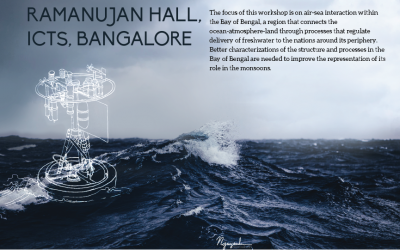Although total rainfall during the South Asian Monsoon varies by only ~10% across India, spatiotemporal variability in precipitation is large, difficult to predict, and has far-reaching implications for local communities. The dependence of an agrarian economy on rainfall makes prediction of monsoon variability of paramount importance to India and other countries in South Asia. Currently, representation of the monsoon in global climate models exhibits large biases over the Indian Ocean. In particular, skill in prediction of intraseasonal oscillations (ISOs), which are associated with active (wet) and break (dry) periods, is modest compared to its potential, giving reason to strive for improved forecast capabilities. Ocean-atmosphere coupled models have greater skill in representing ISOs compared to stand-alone atmospheric models. This discrepancy highlights the importance of air-sea interaction to ISO prediction.
The focus of this workshop is on air-sea interaction within the Bay of Bengal, a region that connects the ocean-atmosphere-land through processes that regulate delivery of freshwater to the nations around its periphery. During summer, southwesterly winds gather moisture from the ocean and carry it deep inland over the Indian subcontinent, bringing welcome rains to a parched land. During winter, the winds reverse, and the ocean circulation responds by dispersing terrestrial runoff into the bay. This freshwater impacts the ocean’s circulation through modification of upper ocean structure and surface temperature, thus affecting ocean coupling with the atmosphere. Better characterizations of the structure and processes in the Bay of Bengal are needed to improve the representation of its role in the monsoons.
Participation is by invitation only.
Accommodation for outstation/non-local participants will be provided at our on campus ICTS guest house.
 icts
icts res
res in
in

